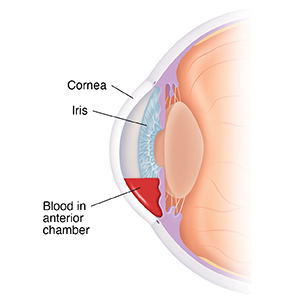A
B
C
D
E
F
G
H
I
J
K
L
M
N
O
P
Q
R
S
T
U
V
W
X
Y
Z
Click a letter to see a list of conditions beginning with that letter.
Click 'Topic Index' to return to the index for the current topic.
Click 'Library Index' to return to the listing of all topics.
Bleeding in the Front of the Eye (Hyphema)
Hyphema is bleeding in the front part of your eye. The cornea is the clear cover on the front of your eye. The colored part of your eye (the iris) lies behind it. The space between them is the anterior chamber. An injury to your eye is the most common cause of bleeding in this space.

When to go to the emergency room (ER)
Hyphema is a medical emergency. Call your healthcare provider or have someone take you to the nearest hospital. Don't use any home remedies before going to the healthcare provider or hospital. Signs and symptoms include:
-
Bleeding in the front part of your eye This often forms a layer as it settles. In severe cases, the entire anterior chamber is filled with blood.
-
Eye pain or nausea
-
Increased sensitivity to light
-
Decreased vision. Even a small amount of blood in the anterior chamber can make it hard to see.
What to expect in the ER
-
A healthcare provider will give you a complete eye exam. They will use a microscope with a bright light (a slit lamp microscope).
-
Your vision and the pressure within your eye will be checked.
-
Mild hyphema may be treated at home. You will need to limit your activity, keep your head raised, and use eye drops and an eye shield. In addition, eye drops will be prescribed for you.
-
In rare cases when bleeding is severe or your eye pressure increases, you may be admitted to the hospital for treatment.
-
Hyphema often goes away on its own in time. If not, you may have a procedure to remove the blood from your eye.
Follow-up
If you’re treated at home, you are likely to see your healthcare provider each day for 3 to 5 days. You may then be checked several times over the next few weeks. This is vital because bleeding may come back again even after treatment. Other parts of your eye may have been injured if trauma caused the bleeding. Traumatic hyphema raises your risk for increased eye pressure (glaucoma). For this reason, you should have routine eye exams for the rest of your life.
Online Medical Reviewer:
Chris Haupert MD
Online Medical Reviewer:
Tara Novick BSN MSN
Online Medical Reviewer:
Whitney Seltman MD
Date Last Reviewed:
12/1/2022
© 2000-2025 The StayWell Company, LLC. All rights reserved. This information is not intended as a substitute for professional medical care. Always follow your healthcare professional's instructions.